Attendees who registered for Author Meetups at the ILA 2017 Conference & Exhibits had the opportunity to spend 10 minutes with each of seven authors in a chosen level (primary, mid-level, or young adult) to learn about their writing and their books. The books reviewed in this weekly column were all featured at Author Meetups.
Ages 4–8
Calling the Water Drum. LaTisha Redding. Ill. Aaron Boyd. 2016. Lee and Low.
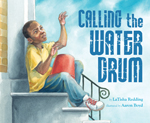 Henri and his parents are in a rickety rowboat, fleeing Haiti in search of a better life in New York City. When the boat capsizes, only Henri is rescued. Henri arrives in the U.S. with only the red bucket his parents used to bail water and a letter with his uncle’s contact information. Encouraged by his uncle, Henri starts drumming on the bucket to express his grief, and eventually to connect with others. Watercolor paintings perfectly express the emotional tone of this poignant story of a young immigrant.
Henri and his parents are in a rickety rowboat, fleeing Haiti in search of a better life in New York City. When the boat capsizes, only Henri is rescued. Henri arrives in the U.S. with only the red bucket his parents used to bail water and a letter with his uncle’s contact information. Encouraged by his uncle, Henri starts drumming on the bucket to express his grief, and eventually to connect with others. Watercolor paintings perfectly express the emotional tone of this poignant story of a young immigrant.
—CA
The Grand Canyon. Jason Chin. 2017. Roaring Brook.
 This informational picture book follows a father and daughter as they explore the Grand Canyon. The illustrations, created with pen-and-ink, watercolor, and gouache, beautifully showcase the awe-inspiring majesty of the canyon. Sidebars detail the geology and ecology of the canyon and borders illustrate its rock strata, fauna, and flora.The story ends with a double gatefold showing the two explorers overlooking “the greatest canyon on Earth.”
This informational picture book follows a father and daughter as they explore the Grand Canyon. The illustrations, created with pen-and-ink, watercolor, and gouache, beautifully showcase the awe-inspiring majesty of the canyon. Sidebars detail the geology and ecology of the canyon and borders illustrate its rock strata, fauna, and flora.The story ends with a double gatefold showing the two explorers overlooking “the greatest canyon on Earth.”
—CA
Hattie & Hudson. Chris Van Dusen. 2017. Candlewick.
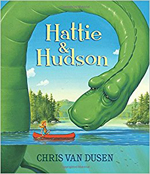 As she paddles on a lake in her red canoe, Hattie’s singing lures a lonely green monster from his deep underwater cave. She is not afraid, but other boaters flee in panic. While the townspeople plan to get rid of “the Deadly Beast,” Hattie and her new friend (whom she names Hudson) must come up with a plan to convince them that they can all share and enjoy the lake.
As she paddles on a lake in her red canoe, Hattie’s singing lures a lonely green monster from his deep underwater cave. She is not afraid, but other boaters flee in panic. While the townspeople plan to get rid of “the Deadly Beast,” Hattie and her new friend (whom she names Hudson) must come up with a plan to convince them that they can all share and enjoy the lake.
—CA
Ninja!: Attack of the Clan (Ninja! #2). Arree Chung. 2017. Henry Holt.
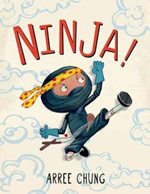 Maxwell is disappointed to find that Mama, sister Cassy, and Papa are too busy to help him hone his ninja skills. When he’s called to dinner one night, he finds no one at the table except the dog eating his miso soup. It’s a “SURPRISE ATTACK!” Colorful comic book-style panels show Ninja Maxwell defending himself against his ninja clan, despite sneaky little Cassy springing a totally unexpected move on him.
Maxwell is disappointed to find that Mama, sister Cassy, and Papa are too busy to help him hone his ninja skills. When he’s called to dinner one night, he finds no one at the table except the dog eating his miso soup. It’s a “SURPRISE ATTACK!” Colorful comic book-style panels show Ninja Maxwell defending himself against his ninja clan, despite sneaky little Cassy springing a totally unexpected move on him.
—SW
Raybot and Weebot! (Raybot #2). Adam F. Watkins. 2017. Price Stern Sloan/Penguin.
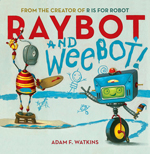 When a crate falls from a truck outside his junkyard, Raybot is delighted to find that it contains a little robot. However, Weebot’s activity level (“He rarely powers down, and he makes a lot of noise, even when it’s time to go to sleep.”) is overwhelming, and Raybot begins to long for his peaceful pre-Weebot life. Pair this book with Raybot (2016) for a fun-filled read aloud on robots.
When a crate falls from a truck outside his junkyard, Raybot is delighted to find that it contains a little robot. However, Weebot’s activity level (“He rarely powers down, and he makes a lot of noise, even when it’s time to go to sleep.”) is overwhelming, and Raybot begins to long for his peaceful pre-Weebot life. Pair this book with Raybot (2016) for a fun-filled read aloud on robots.
—CA
The Space Disaster (The Mad Scientist Academy #3). Matthew McElligott. 2017. Crown/Random House.
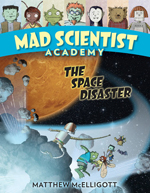 When the planetarium computer malfunctions, Dr. Cosmic’s astronomy lesson (challenging the young monster students to identify where they are in the solar system) becomes a lesson in survival as they are literally sent into space. There is plenty of fun and science packed into this comic-paneled book. Students can read The Dinosaur Disaster (2015) and The Weather Disaster (2016) while waiting for Dr. Cosmic’s next science lessons.
When the planetarium computer malfunctions, Dr. Cosmic’s astronomy lesson (challenging the young monster students to identify where they are in the solar system) becomes a lesson in survival as they are literally sent into space. There is plenty of fun and science packed into this comic-paneled book. Students can read The Dinosaur Disaster (2015) and The Weather Disaster (2016) while waiting for Dr. Cosmic’s next science lessons.
—CA
Ages 9–11
Abby in Wonderland (Whatever After: Special Edition). Sarah Mlynowski. 2017. Scholastic.
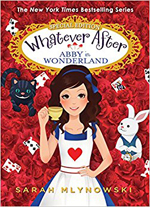 In the 10 previous books in Mlynowski’s popular series, siblings Abby and Jonah find a magic mirror that leads them into fairy tale adventures. In this Whatever After special edition, Abby and her best friends Frankie and Robin are spending the day at the castle-like home of her not-such-a-good-friend Penny. The girls find themselves in Lewis Carroll’s Alice’s Adventures in Wonderland when Frankie falls into a hole in the backyard.
In the 10 previous books in Mlynowski’s popular series, siblings Abby and Jonah find a magic mirror that leads them into fairy tale adventures. In this Whatever After special edition, Abby and her best friends Frankie and Robin are spending the day at the castle-like home of her not-such-a-good-friend Penny. The girls find themselves in Lewis Carroll’s Alice’s Adventures in Wonderland when Frankie falls into a hole in the backyard.
—CA
Katana at Super Hero High (DC Super Hero Girls #4). Lisa Yee. 2017. Random House.
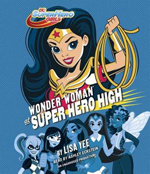 While attending Super Hero High, Katana practices the sword skills she learned from her grandmother, the first woman Samurai warrior who mysteriously disappeared. When Katana finds herself guardian of 100 Samurai swords and the recipient of a mysterious haiku ending with the line “Prepare for battle,” all the super heroes need to use their special skills to help Katana battle the Dragon King, who intends to claim Muteki Sword, the legendary Invincible Sword.
While attending Super Hero High, Katana practices the sword skills she learned from her grandmother, the first woman Samurai warrior who mysteriously disappeared. When Katana finds herself guardian of 100 Samurai swords and the recipient of a mysterious haiku ending with the line “Prepare for battle,” all the super heroes need to use their special skills to help Katana battle the Dragon King, who intends to claim Muteki Sword, the legendary Invincible Sword.
—SW
Lucky Broken Girl. Ruth Behar. 2017. Nancy Paulsen/Penguin.
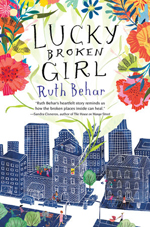 After a bad car accident, 11-year-old Ruthie is in a full body cast. While spending the year lying flat in bed, she learns to see her life in a new way as she gains a better understanding of her Jewish Cuban family and its traditions, discovers new talents, and overcomes sorrow and disappointment in ways she does not expect.
After a bad car accident, 11-year-old Ruthie is in a full body cast. While spending the year lying flat in bed, she learns to see her life in a new way as she gains a better understanding of her Jewish Cuban family and its traditions, discovers new talents, and overcomes sorrow and disappointment in ways she does not expect.
—SW
Some Writer!: The Story of E. B. White. Melissa Sweet. 2016. Houghton Mifflin Harcourt.
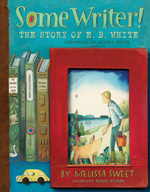 Melissa Sweet uses a scrapbook-style compilation of letters, journals entries, family photos, manuscript excerpts, quotes, and her original mixed-media collage artwork and a warm narrative to present the life and work of beloved children’s book author E. B. White (1899-1985). Chapters on the writing of Stuart Little and Charlotte’s Web, which exemplify White’s love of words and his process of crafting them into stories, are particularly interesting.
Melissa Sweet uses a scrapbook-style compilation of letters, journals entries, family photos, manuscript excerpts, quotes, and her original mixed-media collage artwork and a warm narrative to present the life and work of beloved children’s book author E. B. White (1899-1985). Chapters on the writing of Stuart Little and Charlotte’s Web, which exemplify White’s love of words and his process of crafting them into stories, are particularly interesting.
—CA
The Sweetest Sound. Sherri Winston. 2017. Little, Brown.
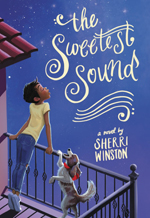 Shy Cadence fantasizes about performing, promising herself that someday she will share her secret talent: singing. When Candace and best friends Zara and Faith form a trio to compete for places in a Youth Choir, Faith suggests that she lip sync to Cadence’s singing to gain a solo role. Cadence must overcome her shyness, question friendships, and decide how she will keep the promise she has made to herself.
Shy Cadence fantasizes about performing, promising herself that someday she will share her secret talent: singing. When Candace and best friends Zara and Faith form a trio to compete for places in a Youth Choir, Faith suggests that she lip sync to Cadence’s singing to gain a solo role. Cadence must overcome her shyness, question friendships, and decide how she will keep the promise she has made to herself.
—SW
Ages 12–14
In the Shadow of Liberty: The Hidden History of Slavery, Four Presidents, and Five Black Lives. Kenneth C. Davis. 2016. Henry Holt.
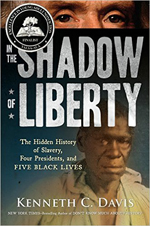 Davis peels back the layers of history from George Washington’s move to Mount Vernon in 1757 to the death of Andrew Jackson’s personal slave, Alfred Jackson, in 1901. The book covers the views of four U.S. Presidents (George Washington, Thomas Jefferson, James Madison, and Andrew Jackson) toward slavery and their relationships with their slaves. Through the detailed narratives of five enslaved people against the backdrop of historical events, this book explores the role slavery played in the founding of America
Davis peels back the layers of history from George Washington’s move to Mount Vernon in 1757 to the death of Andrew Jackson’s personal slave, Alfred Jackson, in 1901. The book covers the views of four U.S. Presidents (George Washington, Thomas Jefferson, James Madison, and Andrew Jackson) toward slavery and their relationships with their slaves. Through the detailed narratives of five enslaved people against the backdrop of historical events, this book explores the role slavery played in the founding of America
—SW
Lily & Dunkin. Donna Gephart. 2016. Delacorte/Random House.
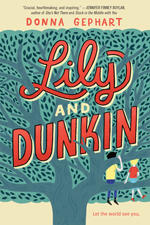 Lily & Dunkin is a powerful story about a new friendship between Lily, a transgender girl, and Dunkin, a boy dealing with bipolar disorder. Told in alternating first-person narratives, their stories unfold as tall Dunkin joins the basketball team, stops his medication for bipolar disorder to increase his stamina and speed, and turns his back on his friendship with Lily, who must face the bullying and torment of the other players alone.
Lily & Dunkin is a powerful story about a new friendship between Lily, a transgender girl, and Dunkin, a boy dealing with bipolar disorder. Told in alternating first-person narratives, their stories unfold as tall Dunkin joins the basketball team, stops his medication for bipolar disorder to increase his stamina and speed, and turns his back on his friendship with Lily, who must face the bullying and torment of the other players alone.
Piecing Me Together. Renée Watson. 2017. Bloomsbury.
 As part of her scholarship to prestigious St. Francis High School, Jade must participate in Women to Women, a mentorshop program for “at-risk” girls. Jade is skeptical about what her mentor, who appears to have many challenges of her own, can teach her. In learning to appreciate her identity and aspirations, Jade discovers she wants to develop her talent for collage art and to help people rather than be considered someone who needs help.
As part of her scholarship to prestigious St. Francis High School, Jade must participate in Women to Women, a mentorshop program for “at-risk” girls. Jade is skeptical about what her mentor, who appears to have many challenges of her own, can teach her. In learning to appreciate her identity and aspirations, Jade discovers she wants to develop her talent for collage art and to help people rather than be considered someone who needs help.
—SW
The Survivors Club: The True Story of a Very Young Prisoner of Auschwitz. Michael Bornstein & Debbie Bornstein Holinstat. 2017. Farrar Straus Giroux.
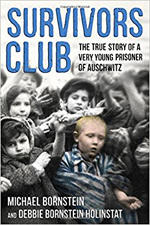 Four-year-old Michael Bornstein was one of the 52 children under the age of eight (out of the hundreds of thousands of children sent to Auschwitz) who were liberated by the Soviet Army in 1945. Based on extensive interviews and research, this personal story of survival during the Holocaust, from Nazi occupation of Michael’s hometown of Żarki, Poland, to immigration to the United States, ends with a photo album of Michael’s family, “The Survivors Club.”
Four-year-old Michael Bornstein was one of the 52 children under the age of eight (out of the hundreds of thousands of children sent to Auschwitz) who were liberated by the Soviet Army in 1945. Based on extensive interviews and research, this personal story of survival during the Holocaust, from Nazi occupation of Michael’s hometown of Żarki, Poland, to immigration to the United States, ends with a photo album of Michael’s family, “The Survivors Club.”
—CA
Toni (Blacktop #4). LJ Alonge. Ill. Raul Allen. 2017. Grosset & Dunlap/Penguin.
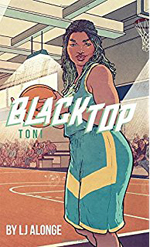 Toni’s heart is in basketball, even though she is not very liked by Coach Wise or her teammates. Coach Wise tolerates her attitude until she punches a player on an opposing team and her team is dropped from league play. Toni, who has lived in group and foster homes her whole life, loses friends and her special interest in art, but a growing friendship challenges her to care about her family, Coach Wise, and her friends on the team in new ways.
Toni’s heart is in basketball, even though she is not very liked by Coach Wise or her teammates. Coach Wise tolerates her attitude until she punches a player on an opposing team and her team is dropped from league play. Toni, who has lived in group and foster homes her whole life, loses friends and her special interest in art, but a growing friendship challenges her to care about her family, Coach Wise, and her friends on the team in new ways.
—SW
Ages 15+
Girl Rising: Changing the World One Girl at a Time. Tanya Lee Stone. 2017. Wendy Lamb/Random House.
 Inspired by the documentary film Girl Rising, Tanya Lee Stone explores how education can break the cycle of poverty. Based on video interviews, the narrative, accompanied by full-page photographs, presents stories of girls from Afghanistan, Cambodia, Egypt, Ethiopia, Haiti, India, Nepal, Peru, and Sierra Leone who tell how they survived experiences of slavery, rape, child labor, and forced marriage when they were not yet teenagers.
Inspired by the documentary film Girl Rising, Tanya Lee Stone explores how education can break the cycle of poverty. Based on video interviews, the narrative, accompanied by full-page photographs, presents stories of girls from Afghanistan, Cambodia, Egypt, Ethiopia, Haiti, India, Nepal, Peru, and Sierra Leone who tell how they survived experiences of slavery, rape, child labor, and forced marriage when they were not yet teenagers.
—SW
The Inexplicable Logic of My Life. Benjamin Alire Sáenz. 2017. Clarion/Houghton Mifflin Harcourt.
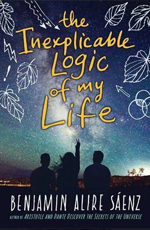 Mild-mannered, patient Salvador, who lives with his adoptive gay Mexican-American father in El Paso, is confused by his intensely angry reaction to taunting by school bullies. He becomes more puzzled about his self-worth and identity on the death of his beloved grandmother and the reappearance of Dad’s former lover in their lives. As he ponders how to present himself in college application essays, Sal wonders what he can offer to friends and the world.
Mild-mannered, patient Salvador, who lives with his adoptive gay Mexican-American father in El Paso, is confused by his intensely angry reaction to taunting by school bullies. He becomes more puzzled about his self-worth and identity on the death of his beloved grandmother and the reappearance of Dad’s former lover in their lives. As he ponders how to present himself in college application essays, Sal wonders what he can offer to friends and the world.
—SW
The You I’ve Never Known. Ellen Hopkins. 2017. Margaret K. McElderry/Simon & Schuster.
 Ariel, who has spent her life on the move with her alcoholic, abusive father, hopes to stay in Sonora, California, long enough to finish high school and escape his control. Seventeen-year-old Maya deliberately gets pregnant with a 27-year-old soldier, marries and accompanies him to Fort Bragg, North Carolina, to avoid moving to Los Angeles with her Scientology-obsessed mother. The girls’ stories (told in free verse for Ariel and prose for Maya) come together deftly in Hopkins’s beautifully-crafted novel.
Ariel, who has spent her life on the move with her alcoholic, abusive father, hopes to stay in Sonora, California, long enough to finish high school and escape his control. Seventeen-year-old Maya deliberately gets pregnant with a 27-year-old soldier, marries and accompanies him to Fort Bragg, North Carolina, to avoid moving to Los Angeles with her Scientology-obsessed mother. The girls’ stories (told in free verse for Ariel and prose for Maya) come together deftly in Hopkins’s beautifully-crafted novel.
—CA
Wildman. J. C. Geiger. 2017. Hyperion/Disney.
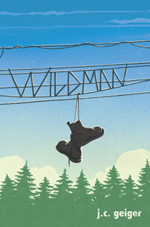 Valedictorian, college-bound Lance Hendricks is returning to his home in Oregon from a music audition in Seattle when his cherished Buick, a gift from his father who abandoned him, breaks down in a tiny town. While repairs are made and his mother and friends call and text arranging to get him home to the life he has planned, Lance finds himself in a culture he doesn’t understand and discovers new ways of being that he could never have imagined.
Valedictorian, college-bound Lance Hendricks is returning to his home in Oregon from a music audition in Seattle when his cherished Buick, a gift from his father who abandoned him, breaks down in a tiny town. While repairs are made and his mother and friends call and text arranging to get him home to the life he has planned, Lance finds himself in a culture he doesn’t understand and discovers new ways of being that he could never have imagined.
—SW
Sandip LeeAnne Wilson serves as professor in the School of Education and the English Department of Husson University, Bangor, Maine. Carolyn Angus is former Director of the George G. Stone Center for Children's Books, Claremont Graduate University, in Claremont, California.